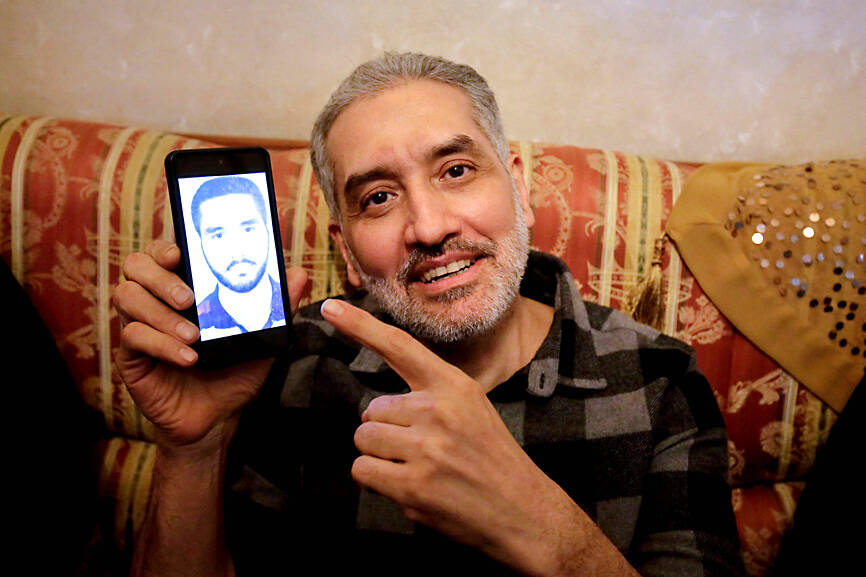NOTORIOUS JAIL: Even from a distance, prisoners maimed by torture, weakened by illness and emaciated by hunger, could be distinguished
AFP, BEIRUT
Armed men broke the bolts on the cell and the prisoners crept out: haggard, bewildered and scarcely believing that their years of torment in Syria’s most brutal jail were over.
“What has happened?” asked one prisoner after another.
“You are free, come out. It is over,” cried the voice of a man filming them on his telephone. “Bashar has gone. We have crushed him.”

The Saydnaya prison near Damascus is pictured from the air on Monday.
Photo: AFP
The dramatic liberation of Saydnaya prison came hours after rebels took the nearby capital, Damascus, having sent former Syrian president Bashar al-Assad fleeing after more than 13 years of civil war.
In the video, dozens of gaunt men emerged, some too weak to walk and carried by their companions.
No furniture was visible in their cell except a few thin covers on the floor. The doors were rusted, and the walls were stained with damp and dirt.

Moaz Merheb, 51, displays an old picture from when he went to jail, in Tripoli, Lebanon, on Tuesday, after he returned to his home following 18 years of imprisonment in Syria’s Saydnaya prison.
Photo: AFP
In another wing of the complex, women’s cells were opened. Before the door of one of them a lost child was waiting.
Several of the women cried out: “I am scared.”
They were visibly terrified of being mistreated by the armed men streaming through the prison.
“He is fallen,” the men called. “You can come out.”
However, freeing all the prisoners from Saydnaya is harder than it looks.
The prison is thought to descend several levels underground.
Untold numbers of prisoners might still be locked inside them.
“There are hundreds, maybe thousands of prisoners held two or three floors underground, behind electronic locks and hermetically sealed doors,” Middle East Institute research group fellow Charles Lister said.
The White Helmets, a Syrian rescue group, said it is searching for “hidden underground cells.”
Since Sunday, their members have been bashing down walls with sledgehammers and iron bars, and using audio sensors and sniffer dogs.
“We are working as hard as we can, but so far there is no sign of prisoners in the basements and labyrinths,” the group’s leader, Raed Saleh, said in a message on X.
He had earlier said he was “preparing for the worst.”
The White Helmets offered a US$3,000 reward for anyone who enables them to find the secret lockups. It has called on security staff of the former leadership to help, promising not to identify them.
The Syrian Observatory for Human Rights, a group that gathers data about the war, estimated in 2022 that more than 100,000 people have died, many of them under torture, in al-Assad’s prisons since the civil war erupted in 2011.
The group said about 30,000 people were held in Saydnaya, of whom only 6,000 had been released.
Amnesty International dubbed the prison a “human slaughterhouse,” recording thousands of executions there.
The London-based rights group said the prison was designed to “exterminate” inmates.
Now freed, crowds of those former detainees were wandering the streets of Damascus, about 30km away.
Even from far off, they were distinguishable by the marks of their ordeal: maimed by torture, weakened by illness and emaciated by hunger.
Some could not speak, even to say their names or where they were from. Others gurgled wordlessly — traumatized by the torture they had suffered, their companions said.
Some of them had been in Saydnaya since the rule of Bashar al-Assad’s father, Hafez, which ended over two decades ago. Few of them had any idea where to go now.
After al-Assad fled, crowds of Syrians flocked to the prison to search for their loved ones.
Aida Taher, 65, said she was still looking for her brother, who was arrested in 2012.
“I ran like crazy” to get to the prison, she said.
“But I found out that some of the prisoners were still in the basements. There are three or four floors underground,” she added. “They told me the doors can’t be opened because they don’t have the right codes.”
The White Helmets called on victims’ relatives to be patient “and not to dig up the prisons themselves.”
It warned that could “lead to material evidence being destroyed that could be essential for revealing facts and supporting efforts to obtain justice.”
Lining up at the prison, families showed black-and-white photographs of young men.
Some carried pictures of demonstrators waving flags of the 2011 “revolution” in rebel provinces.
They asked whether anyone had seen them, whether they were in Saydnaya — or whether the years of chaos since that uprising had left them dead, never to stagger out of the filthy prison.
“We have been oppressed for long enough,” Taher said. “We want our children to come home.”



